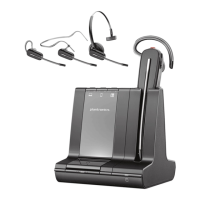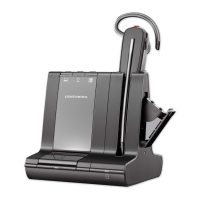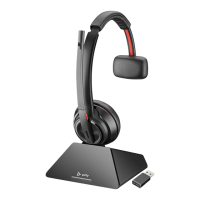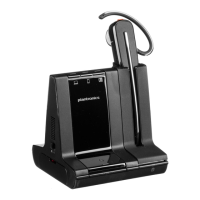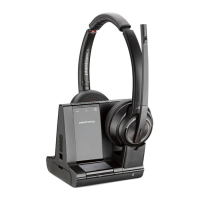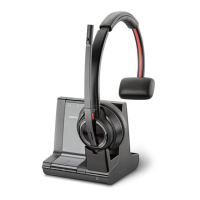Do you have a question about the Poly Savi 8240 UC and is the answer not in the manual?
Poly's adoption of DECT Forum recommendations for security enhancements in DECT products.
Identification of headset components including earloop, eartip, buttons, battery, LED, and microphone.
Illustrations of the charge stand for Savi 8240 UC and Savi 8245 UC, noting charging functions.
Illustrations of charge accessories for Savi 8240 UC and Savi 8245 UC, noting charging functions.
Information on connecting the D400 DECT USB adapter and its standard LED status indicators.
Information on connecting the D200 DECT USB adapter and its LED status indicators for Microsoft Teams.
Instructions for installing the headset battery and assembling the headset for wearing styles.
Steps to position and install the replaceable headset battery securely into place.
Guidance on selecting and attaching earloops and eartips for a comfortable headset fit.
Detailed steps for choosing and attaching the correct earloop and eartip for the right ear.
Detailed steps for choosing and attaching the correct earloop and eartip for the left ear.
Guidance on positioning the headset for optimal microphone placement near the cheek.
Instructions for assembling the headset with the headband for over-the-head wearing style.
Steps to assemble the headset with the headband for behind-the-head wearing style.
Instructions for placing the headset in the charge cradle and charging indicators.
Procedure for charging a spare headset battery using the charge stand or accessory.
Steps to replace the headset battery during an active call without interruption.
Information on the headset's talk time in wideband and narrowband modes.
Methods for determining the headset's battery status via voice prompts or the Poly Lens App.
Steps to configure the DECT USB adapter for audio playback on Windows and Mac systems.
Instructions for keeping Poly device firmware and software up-to-date using the Poly Lens App.
Overview of headset buttons and functions for basic operation.
Procedure for turning the headset on and off by sliding the power button.
Instructions for making, answering, and ending calls using the headset's call button.
Guidance on fine-tuning headset volume using the volume controls.
How to mute or unmute the headset during an active call using the mute button.
How to interact with Microsoft Teams and Skype for Business using the headset's call button.
Understanding how the headset's LED indicates Microsoft Teams notifications.
How to change the voice prompt language using the Poly Lens Desktop App.
Steps to optimize audio quality by switching between wideband and narrowband modes.
How to limit the amount of nearby conversation transmitted during calls.
Guidance on adjusting the headset's wireless range for PC audio quality and user density.
Steps to set up a conference call with up to 3 additional Savi headsets.
Instructions for re-subscribing a disconnected or separately purchased DECT USB adapter.
Troubleshooting common headset problems like instability, degraded talk time, and battery replacement.
Troubleshooting softphone dialling problems, audio configuration, and connection failures.
Guidance on interacting with Microsoft Teams and Skype for Business using headset controls.
Information on using the headset with softphones other than Microsoft Teams.
Steps to adjust headset and computer volumes to resolve low or high volume issues.
Troubleshooting steps for distorted sound or echo, including microphone positioning.
Steps to resolve issues where no audio is heard through PC speakers.
Troubleshooting steps for no audio connection to the PC, such as reconnecting the USB adapter.
Poly's adoption of DECT Forum recommendations for security enhancements in DECT products.
Identification of headset components including earloop, eartip, buttons, battery, LED, and microphone.
Illustrations of the charge stand for Savi 8240 UC and Savi 8245 UC, noting charging functions.
Illustrations of charge accessories for Savi 8240 UC and Savi 8245 UC, noting charging functions.
Information on connecting the D400 DECT USB adapter and its standard LED status indicators.
Information on connecting the D200 DECT USB adapter and its LED status indicators for Microsoft Teams.
Instructions for installing the headset battery and assembling the headset for wearing styles.
Steps to position and install the replaceable headset battery securely into place.
Guidance on selecting and attaching earloops and eartips for a comfortable headset fit.
Detailed steps for choosing and attaching the correct earloop and eartip for the right ear.
Detailed steps for choosing and attaching the correct earloop and eartip for the left ear.
Guidance on positioning the headset for optimal microphone placement near the cheek.
Instructions for assembling the headset with the headband for over-the-head wearing style.
Steps to assemble the headset with the headband for behind-the-head wearing style.
Instructions for placing the headset in the charge cradle and charging indicators.
Procedure for charging a spare headset battery using the charge stand or accessory.
Steps to replace the headset battery during an active call without interruption.
Information on the headset's talk time in wideband and narrowband modes.
Methods for determining the headset's battery status via voice prompts or the Poly Lens App.
Steps to configure the DECT USB adapter for audio playback on Windows and Mac systems.
Instructions for keeping Poly device firmware and software up-to-date using the Poly Lens App.
Overview of headset buttons and functions for basic operation.
Procedure for turning the headset on and off by sliding the power button.
Instructions for making, answering, and ending calls using the headset's call button.
Guidance on fine-tuning headset volume using the volume controls.
How to mute or unmute the headset during an active call using the mute button.
How to interact with Microsoft Teams and Skype for Business using the headset's call button.
Understanding how the headset's LED indicates Microsoft Teams notifications.
How to change the voice prompt language using the Poly Lens Desktop App.
Steps to optimize audio quality by switching between wideband and narrowband modes.
How to limit the amount of nearby conversation transmitted during calls.
Guidance on adjusting the headset's wireless range for PC audio quality and user density.
Steps to set up a conference call with up to 3 additional Savi headsets.
Instructions for re-subscribing a disconnected or separately purchased DECT USB adapter.
Troubleshooting common headset problems like instability, degraded talk time, and battery replacement.
Troubleshooting softphone dialling problems, audio configuration, and connection failures.
Guidance on interacting with Microsoft Teams and Skype for Business using headset controls.
Information on using the headset with softphones other than Microsoft Teams.
Steps to adjust headset and computer volumes to resolve low or high volume issues.
Troubleshooting steps for distorted sound or echo, including microphone positioning.
Steps to resolve issues where no audio is heard through PC speakers.
Troubleshooting steps for no audio connection to the PC, such as reconnecting the USB adapter.
This document describes the Poly Savi 8240/8245 UC Wireless DECT Headset System for computers, providing a comprehensive user guide for its functions, features, and maintenance. The system is designed for computer-based communication, offering a wireless DECT headset experience.
The Poly Savi 8240/8245 UC is a wireless DECT headset system primarily designed for use with computers. It enables users to make, answer, and end calls, adjust volume, and mute the microphone, all wirelessly. The system includes a DECT USB adapter that connects to a computer, facilitating audio streaming and call control. The headset is pre-subscribed to the USB adapter, ensuring a ready-to-use experience upon initial setup. It supports both wideband and narrowband audio modes, allowing users to optimize audio quality based on their activity, whether for conversations or other audio. The system is compatible with various softphones and is optimized for Microsoft Teams and Skype for Business, offering integrated call control functionalities.
The headset offers a range of usage features designed for convenience and flexibility:
The system incorporates several features related to the physical maintenance and longevity of the device:
| Type | Wireless Headset |
|---|---|
| Wireless Technology | DECT |
| Charging Time | 3 hours |
| DECT Security Certification | Yes |
| Unified Communications (UC) Optimized | Yes |
| Warranty | 2 years |
| Noise Cancellation | Yes |
| Microphone | Noise-canceling microphone |
| Compatibility | PC |
| Base Connections | USB |
| Ear Cushions | Leatherette |
| Wearing Style | Convertible (over-the-ear, over-the-head, behind-the-head) |
| Microphone Frequency Response | Wideband: 100–6800 Hz |
